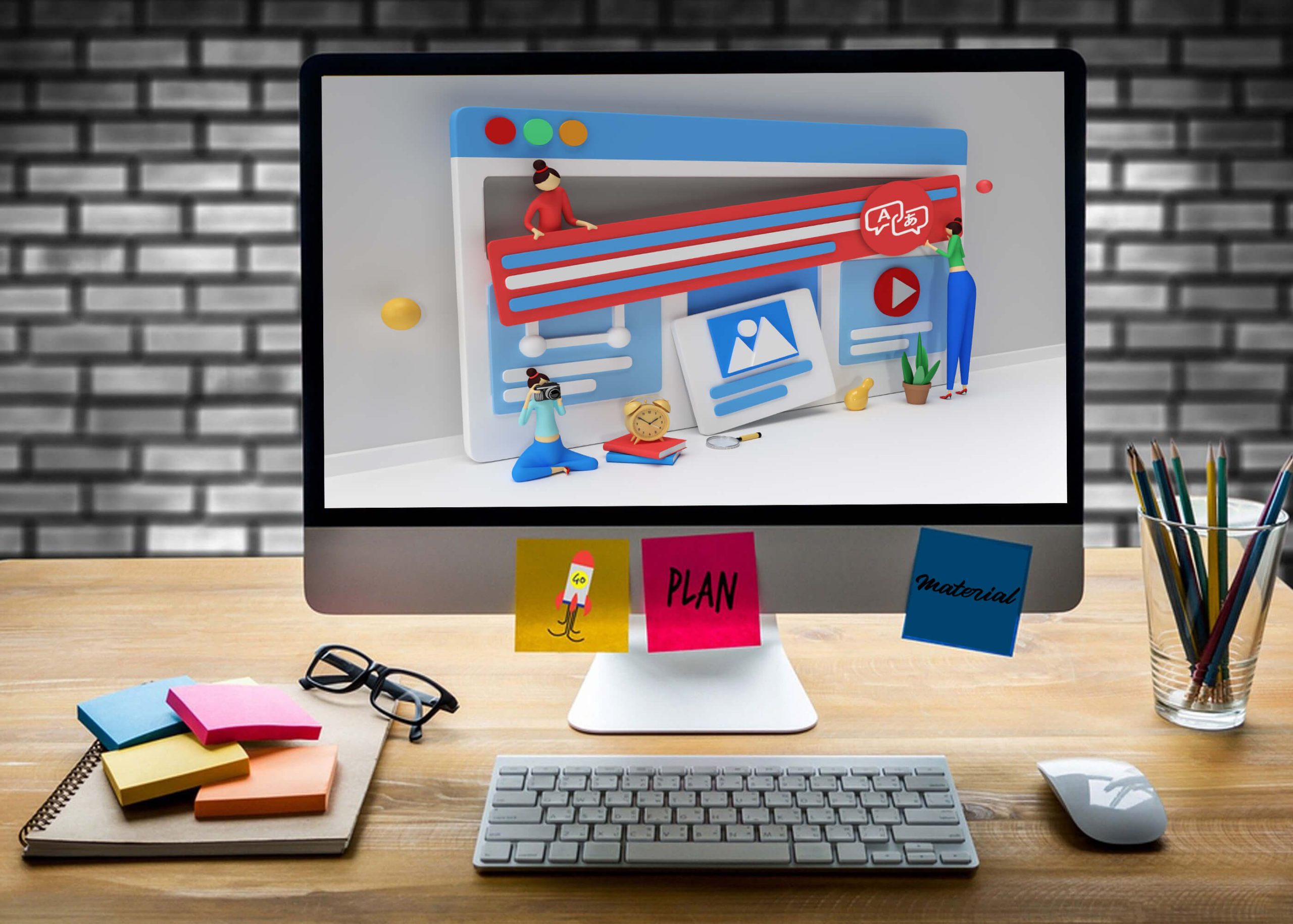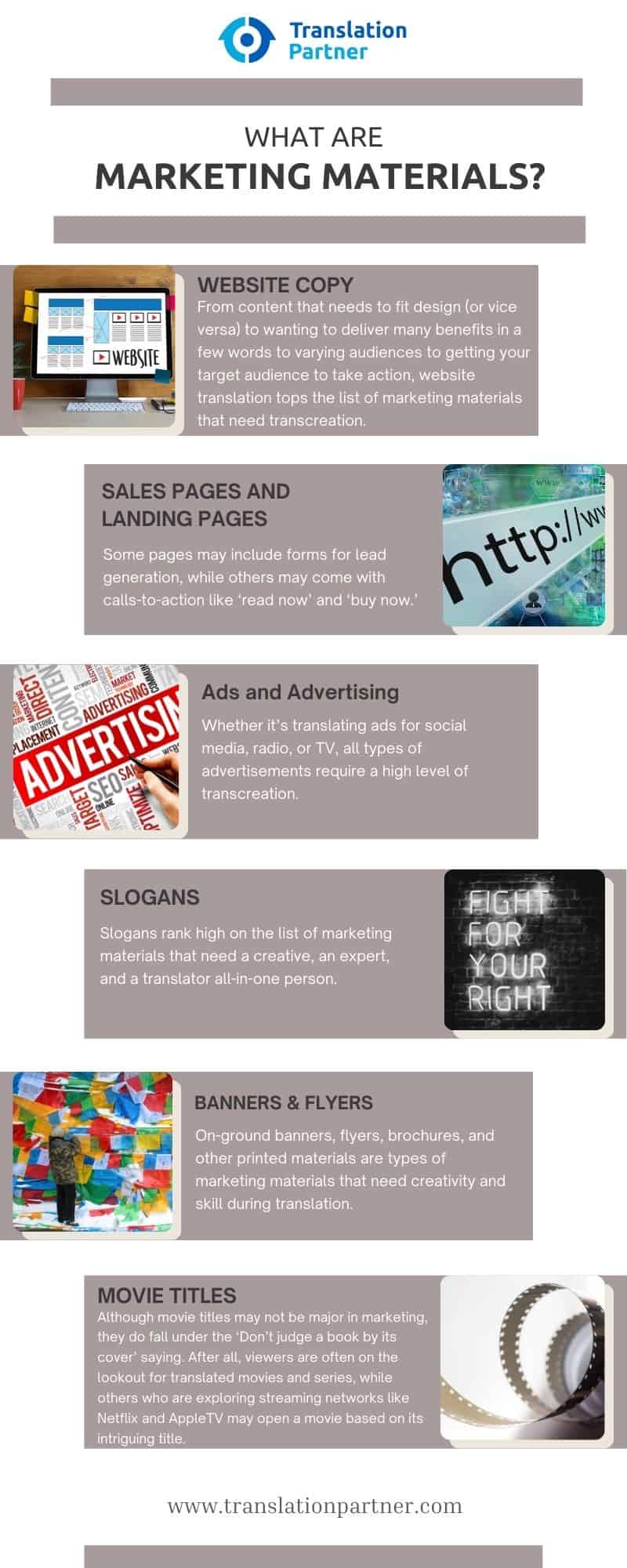6 Things You Need to Know About Translating Marketing Materials

One of the interesting things about translation is that a bit like writing, it’s constantly changing and developing. And with new forms of writing, and accordingly content, emerging almost every day, translation has to adapt.
Among those emerging writing types and formats are marketing content and subsequently marketing translation. That is, translating marketing materials and content for various outlets.
Marketing content, including content creation and copywriting, requires creativity.
And since there’s no one-size-fits-all type of translation, translating marketing content requires a unique skill set that’s not too common among generalist translators.
Translating marketing materials combines brainpower, creativity, and flexibility. And that’s why this particular type of translation is called transcreation.
And because of this rare skill set, marketing translation is fairly expensive compared to other more generic types of translation.
Read on to learn more about transcreation, what qualifies as marketing content, and what makes translating marketing materials hard but also unique.
What is transcreation?
Transcreation is a combination of two words: translation and content creation.
It’s like reading a text and rewriting it in your own words in a different language while bearing in mind cultural and contextual differences.
So it’s no easy feat!
And if you think of translation as a kind of puzzle, then transcreation is a puzzle with many moving pieces.
Marketing content is one of the top types of content that require transcreation. Translating video content, novels, literature, and websites are other examples of content that need transcreation.
While there are many differences between translation and transcreation, it’s important to remember that transcreation projects require a unique skill set.
This skill set includes:
What are marketing materials?
Marketing materials are different types of content that are used for marketing purposes.
And with the constant need for marketing services and the growing globalization of e-commerce and almost every economic sector, the types of materials that may require translation are also growing.
Here are the most important types of marketing content:
From content that needs to fit design (or vice versa) to wanting to deliver many benefits in a few words to varying audiences to getting your target audience to take action, website translation tops the list of marketing materials that need transcreation.
A website has many moving parts. From the homepage to product pages for e-commerce websites, to service pages for non-e-commerce sites, to the headers and footers, there are lots of elements that need to translate.
Similar to website copywriting are sales pages and landing pages, which are web pages used for marketing and sales.
Some pages may include forms for lead generation, while others may come with calls-to-action like ‘read now’ and ‘buy now.’
And getting an audience to take action and buy a product is no easy task.
Add in that sales and landing pages need expert translators to ensure that potential customers don’t leave your site or landing page because the copy sounds odd or funny.
Whether it’s translating ads for social media, radio, or TV, all types of advertisements require a high level of transcreation.
Similarly translating marketing campaigns such as Google ad campaigns, TV ads, or a combination of those, needs creativity and transcreation.
Slogans rank high on the list of marketing materials that need a creative, an expert, and a translator all-in-one person.
Keep reading to see how some major international brands that spend millions of dollars on marketing and ads have failed when it came to translating their slogans!
Request A FREE Translation Cost Estimate!
Click the below button and request a free price quote for translation services—no commitment on your side.
On-ground banners, flyers, brochures, and other printed materials are types of marketing materials that need creativity and skill during translation.
From adapting to design and language nuances to cultural hints, lots can go wrong when translating marketing materials, especially those that are printed and can’t be easily changed.
Although movie titles may not be major in marketing, they do fall under the ‘Don’t judge a book by its cover’ saying. After all, viewers are often on the lookout for translated movies and series, while others who are exploring streaming networks like Netflix and AppleTV may open a movie based on its intriguing title.
Netflix, for example, uses transcreation on a wide scale to translate titles for its movies and series. It also uses a bit of creative translation in its subtitling efforts.
But why is Netflix putting so much hard work into translation and transcreation? Because of its plan to expand to markets across the globe – and it’s doing a pretty good job too!
Do you know how many people have watched the South Korean series Squid Game? Netflix viewers watched 1.65 billion hours of Squid Game in its first 28 days! (CBR)

Why is translating marketing materials hard and expensive?
It’s a question the team at TranslationPartner has been asked frequently.
Translating marketing materials, like those listed above, is different and difficult. Let’s look at why.
Consider the following reasons and requirements for marketing translation:
1. Needs creativity and flexibility in 2 languages
Marketing requires creativity. In translation, you need to be even more creative to deliver the message, tone of voice, and intent.
You also need to be flexible because you can say the same things in many ways.
A translator or transcreator needs to find the best way to say what’s needed without going into too much detail and while giving the translated text a local flavor.
2. It’s a combination of several types of translation
Depending on what is being translated, marketing translation may combine transcreation and localization.
For example, a slogan translated for a Saudi audience will differ from an Emirati one and both will differ from an Egyptian one.
Although all three audiences speak Arabic, the marketing message and copy directed at all three audiences is differs in tone, dialect, cultural context, and habits.
Translating an online course, for example, needs transcreation and localization for the course content along with video and subtitling.
3. Translators need to wear many hats
When translating marketing materials, the translator needs to be a researcher, a bit of a marketer, a creative, and a culturally-aware bilingual speaker and writer.
In addition, after the translator completes the translation-and-writing process, a creative reviewer will have to go over the text for accuracy, a cultural review, and more.
That’s why creative translation is costlier than standard translation and localization.
4. Requires SEO knowledge
Depending on the type of translation required, most web-based marketing content comes with search engine optimization (SEO) requirements.
This is why SEO translation has been gaining importance and focus in recent years.
It’s also quite hard to execute because the process involved requires bilingualism, translation skills, SEO keyword research, and incorporating SEO best practices without hurting the overall text.
Website translation takes the lead when it comes to using SEO translation.
Translating marketing content such as blog posts, social media ads, landing and sales pages, online case studies, among others requires varying degrees of transcreation.
5. Involves many content types and formats
Depending on what you’re working on, marketing translation covers various types and formats such as images and video or audio-visual materials.
Moreover, translating content for print differs from online content, which is different from radio and podcast content formats.
All of these need creative translation to ensure harmony and avoid funny-sounding results for the target audience.
6. Translating marketing materials needs to consider tone
The tone is an important aspect of marketing and copywriting and should therefore be relayed in the translation.
This is quite hard in the writing process itself. And it’s even harder when attempting to transfer into some languages.
Examples of transcreation
Now that you know what makes translating marketing materials difficult, let’s look at a few examples of transcreation. Some of the following examples were a success, while others flopped.
Successful transcreation examples
In its ‘Now is the future’ ad, Samsung used transcreation for its Arabic version of the ad. The translation was “سابق عصره” which also means ‘ahead of its/their time.’
The Coca-Cola Company is quite popular with its slogans and changing designs for its cans. Remember that time when Coca-Cola wrote people’s names on its cans?
This wasn’t limited to English-speaking countries. It was part of every country where Coca-Cola operates and it’s a great example of transcreation.
There were names in Arabic in Arab countries such as Egypt, in Vietnamese in Vietnam, and so on.
Transcreation fails
But then there are a few brands who – sadly and unfortunately – struggled when translating their slogans.
Some attempts were either too literal, while others failed to take the cultural aspect into consideration.
One such marketing translation fail was by Swedish build-it-yourself brand Ikea.
Their “Fearful workbench” is acceptable in Sweden, where it means ‘full speed’ in Swedish. But to an English-speaking audience like the UK, the product was the center of jokes.
Car brands Ford and Mitsubishi both had transcreation flops when they failed to consider what their car names meant in other languages.
Ford’s Pinto did not get the recognition it deserved because ‘pinto’ in Brazilian Portuguese means ‘small genitals.’ (Yikes!)
Similarly, Mitsubishi’s Pajero did not do so well with Spanish speakers in Europe as ‘Pajero’ is Spanish for ‘wanker.’
Finals words and tips
As you can see marketing content has many moving facets. It’s creative. It can be fun. Some brands like to use sarcasm, while others like to play on words.
So there are lots to consider when you need to translate marketing materials, whether it’s for your website or for an in-person event you’re attending, or for something else.
And the rendering into the target language can either make or break your brand!
It’s because of that, and the above-mentioned reasons, that transcreation services tend to be costly. After all, the result is a reflection of your company and its offerings.
Here’s a final tip from a translator-turned-marketer: Use a translation brief for any translation project you have, especially those involving marketing or transcreation needs.
Once you have all the information from the brief laid down, you can choose your language services provider and review translation service quotes from partners or agencies.
Got a project that requires transcreation? Get in touch with TranslationPartner for a free quote and consultation.
